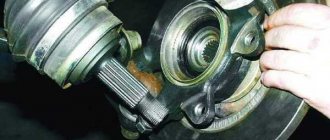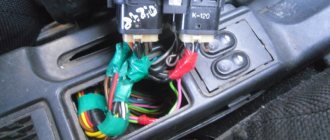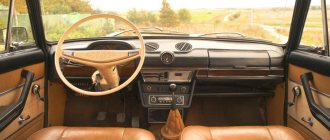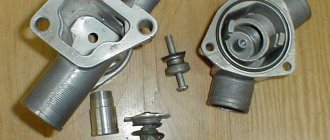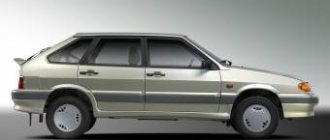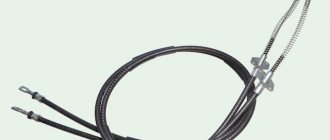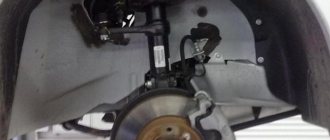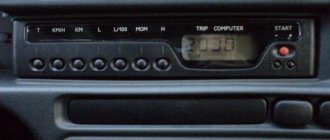Everyone needs a radio in their car. The older generation can listen to the news or chanson, middle-aged people can enjoy jazz, rock and classics, and young people can have fun and loudly “sway” to electronic music or rap.
In this article, we will not touch upon complex Hi-Fi and Hi-End systems that require serious investment - the purchase of an expensive head unit, cables, amplifiers, capacitors and sound processors. As well as calculating subwoofer enclosures, complex podiums, and adjusting the frequency response.
Therefore, we will consider 3 types of simple car audio systems with minimal financial investment.
Three-way front and subwoofer
The three-band front is designed to improve the impression of the audio system and increase the intensity of the sound, and the subwoofer is to correct the error in the lower register for fuller sound. Speakers in a three-way front reproduce sound louder and more accurately, since the emitters of the corresponding sound band have a narrow directivity. Each of them reproduces a narrower range, so the system's speakers are less loaded than with a "two-way front and subwoofer" design.
In practice, there are 2 popular implementations of this system: 1. Three-band front on passive crossovers. In it, special attention must be paid to the location of the speakers. The system setup is based on connecting the top of the subwoofer and the bottom of the midbass and setting the sensitivity of the amplifier input signal. 2. Channel amplification from the radio. The equipment has three pairs of preamplifiers, while four pairs are required to set up the system. It is necessary to resort to certain tricks: you should split the RCA midbass using 2 Y-splitters. Important! It is necessary to choose the right midbass RCA, since it is located approximately at the same distance from the driver with the subwoofer. Channel system setup is much more complicated than the 1st scheme discussed. When setting cutoffs for each type of speaker, it is necessary to take into account individual audio delays, tonal balance and crossover slopes. Without the appropriate knowledge and skills, it is impossible to achieve impeccable sound. Inexperienced car enthusiasts should use a microphone or seek professional help.
Two-way front and subwoofer
This is the most common audio system for cars, as it consists of a small number of components and is easy to install. The composition of the system can be arbitrary (subwoofer, tweeters, etc.) or strictly regulated (two-component speaker system). Ease of installation does not mean that the sound will be of poor quality. The sound depends on the correct settings of the car audio circuit in the vehicle.
The system can be configured according to 2 standard schemes: The first option involves setting up crossover filtering mechanisms and adjusting the sensitivity level of input signals on the Gain amplifier. To further adjust the system, you must: 1. turn on the HPF low-pass filter on the car radio (as well as on the amplifier) for the 1st and 2nd signals; 2. adjust the cutoff for the 3rd and 4th channels (in the 80 Hz area); 3. enable LPF; 4. set the cutoff equal to the cutoff of the 1st or 2nd channel (can be a little higher). On the amplifier, you first need to adjust the sensitivity of the input signals for the 1st and 2nd channels, and then “adjust” the sensitivity of the 3rd and 4th channels to these criteria. The second option involves channel configuration of the system. This method is used for a processor radio. All its parameters are adjusted on the GU (with the exception of signal sensitivity). Getting the ideal sound depends on the standard acoustics, or more precisely, the upper mid-bass and low-end tweeters. Their cutoff is adjusted around 80 Hz. Important! 1. The size of the midbass can be cut in the region of 67-70 Hz, provided that they accurately reproduce the sound below 80 Hz. 2. In the non-processor “Two-way front and subwoofer” system, the bass may fail in the cutoff area. This drawback can be corrected by changing the poles of the subwoofer speaker wire (or switching the phase of the device on the radio if such a function is available).
How to connect speakers to a car radio
But another technological solution appeared. The cross-section of such a cable is 21.15 mm2. Installation kit - any system is only as strong as its weakest link. Tweeters - first, in terms of concepts, there are two main characteristics of the scene - depth and width. I strongly advise you not to read the declared capacities on speakers, amplifiers, or radio tape recorders.
This is the wrong choice of connecting wires, their illiterate laying and poor-quality grounding, or rather the connection of equipment to the car body. In the absence of an anechoic camera, measurements can be taken in a place where reflections from the walls are minimal or completely absent. Connectors for connecting the car radio to the vehicle's on-board network Many manufacturers, when preparing audio for cars, install a connector for connecting the car radio to an internal standard, since there is no international standard.
The subwoofer is usually placed in the trunk of a car, so it should be securely mounted. On a 4-ohm head at 2.83 V, the sensitivity value will be 3 dB higher, which is incorrect. And all the hardware for the crossover will come down to a capacitor that costs a couple of centimes, plus the wiring.
Post navigation
In this case, you can come to the salon and ask to start a Dynaudio circuit, for example. The procedure is labor-intensive, but it is better to do everything wisely right away than to later face possible problems by laying wires, for example, under a rug.
Relative to the second pair of speakers, a place in the rear of the car is selected. Rear: if people are not driving behind you or you are wondering what they hear and whether they even have ears, you should cut off the frequency in the Hz region in favor of the lows. Remaking is always more difficult than doing from scratch.
The phased installation of acoustics in a car, as a rule, begins with increasing the power of the speakers. There is no way to do it without modifications. How to Connect Speakers Correctly
Subtleties of connecting car subwoofers
Connecting a single-coil subwoofer to a monoblock is not at all difficult. It is much more difficult if there are two voice coils or you need to connect several subwoofers.
There are 4 options for connecting a two-coil subwoofer (or several subwoofers): • serial connection; • parallel connection; • combined connection; • connecting each element separately. Each coil switching option is universal. Parallel and series connections achieve opposite effects. In the first case, the total resistance of the coils is reduced by 2 times. For example: when connecting coils with a resistance of 8 ohms each, the total resistance will be 4 ohms. With a series connection type, the resistances of the coils are summed up (increases 2 times). For example: with a series resistance of coils of 3 ohms, each total resistance will be 6 ohms. To obtain more visual information, let’s consider each coil switching option in more detail. 1. Connecting each element separately This connection method is used in cases where there is no monoblock. Using it, you can connect a two-coil subwoofer to a less powerful amplifier. The only correction: the Gain controls should be approximately at the same level, and the resistance of the coils should correspond to the real (operating) power. 2. Parallel connection Due to the reduction in resistance by 2 times, the amplifier can increase the operating load. However, in this case there can be no talk of impeccable sound - as the power increases, the amplifier's control over the subwoofer decreases, which leads to “smeared bass”. 3. Serial connection With it you can achieve more accurate sound. This subwoofer connection scheme is only possible with a powerful amplifier. 4. Combined connection This option involves the simultaneous use of serial and parallel connections. It is used to achieve better sound. The choice of connecting two-coil subwoofers depends on the power of the amplifier and the resistance of the voice coils.
Preface
For some car enthusiasts, having a car radio in the car is just a pleasant addition to the options. Such car owners are not particularly happy about the presence of audio preparation from the factory or a good radio. They pay more attention to the presence of heated seats and steering wheel, climate control operation, seat upholstery and the presence of floor mats.
Yes, you can drive without a car radio, but not all car enthusiasts think so.
Another, larger group of car owners love to listen to music in their car. And they are not at all indifferent to high-quality reproduction.
They read a lot about car acoustics, about amplifiers, crossovers and the car radio itself (in the world it is called a “head unit”). They strive to recreate a more pleasant sound in their car, since they can spend more time in the car than at home.
For such connoisseurs of high-quality music reproduction, the problem often arises is how to make the sound more acceptable and enjoyable.
A simple car audio system is affordable for most, since solving such a problem will require the smallest budget.
A car music system can be very expensive. Often, car owners and music lovers strive to get high-quality sound at minimal cost, and this already borders on fantasy. But let's try to figure it out - is it possible to get acceptable sound for minimal investment?
We will not consider the system - what it should look like ideally, what should be included and how much it might cost. Let’s just try to understand whether it is possible to obtain acceptable sound characteristics in the factory (simple) car audio configuration and what needs to be done.
Features of connecting a capacitor
Connecting a capacitor is not difficult, it is only important to remember some features of connecting the power cable: • from the positive terminal of the battery it is connected to the positive contact of the capacitor, and from the positive terminal of the amplifier; • from the negative terminal ABK the cable is connected to the negative terminal of the capacitor, and from the capacitor - to the negative terminal of the amplifier.
The capacitor and amplifier must be parallel to each other. Good to know! The capacitor must be connected at a minimum distance from the amplifier (no more than 50 cm). The shorter this distance, the greater the effect of the capacitor. The capacitor must be charged before connecting. Otherwise, a short circuit may occur when connecting a discharged device. This rule must be followed impeccably for high-power capacitors. To charge the capacitor, you can use the resistor included with the device. If you don’t have one, then a 12 Volt light bulb will do just fine. The positive cable of the battery is connected directly to the battery, and the negative cable is connected using a resistor to the negative battery. After charging is complete, the negative wire is connected to the battery. The charging time for the device is indicated in the instructions or up to 12-13 Volts on the capacitor voltmeter. If the device is charged using a light bulb, then the extinguishing of the light bulb's spiral can be used as a guide to the end of charging.
Switching between car radio and amplifier
Toggle switching of sources allows you to turn off the amplifier without compromising the sound. This method avoids having to constantly start the engine to recharge the battery. Thanks to it, the battery remains intact and music is played. The improved car audio connection diagram involves the use of 3 toggle switches (one 2-pin and two 6-pin). When you move the toggle switches to the lower position, sound comes from the amplifier; if you move the control to the upper position, the sound will come from the subwoofer.
* Bi-channel amplification To connect the power, you must select connecting cables with a large cross-section. The rating of the complete fuse for the battery must be equal to or greater than the sum of the ratings of all fuses of the amplifier and radio. For example: if the fuse of the radio is 15 A, and the amplifier is 20 A, then the battery fuse rating should be at least 40-45 A. The connection cable is usually blue. To turn on the device remotely, a standard cross-section wire is suitable. To make the task easier, you can purchase a ready-made set of cables. It differs for 2- and 4-channel amplifiers. When purchasing a set of connecting connection wires, additionally purchase 5 m of ground wire. In the standard kit, its length does not exceed 1 m. The radio and its amplifier are connected using RCA, shaped like a tulip bud. The amplifier has an “Input” connector for this plug (for the radio - “Real”, “Front”, etc.). So, the blue cable is connected to the “REM” pin, the black wire to the “GND”. The subwoofer can be connected to the amplifier using a bridge circuit. When choosing this option, the power of the channels is summed. Please note that most bridged amplifiers will not drive loads below 4 ohms. You cannot connect speakers and a subwoofer to the amplifier at the same time, as the equipment may burn out. A detailed diagram for connecting music to a car with an amplifier is indicated on the device itself or in the instructions. * Connecting a four-channel amplifier To prevent interference in the speaker, run the power and signal wires on opposite sides of the vehicle body. Don't forget about the common fuse. When connecting, it is necessary to take into account all three fuses: two amplifiers and one radio. * Connecting a radio The main mistake that car enthusiasts make when connecting a car radio is connecting its positive wire from the cigarette lighter. This leads to the fact that the power of the audio equipment is reduced (a flashing light appears on the radio and the sound quality is distorted). We strongly recommend connecting the radio using a high-quality battery cable using an additional fuse. Moreover, the closer the fuse is to the battery, the higher the protection of the power cable (not the battery, as many people mistakenly think). The most common wire is 8 Ga. The maximum permissible fuse for it is 50 A. The following rule applies: you can install a fuse of a lower rating, but you cannot install a larger one. It is necessary to firmly attach the wire to the body so that during vibration it, along with the fuse, does not move into the moving parts of the engine. The area where the fuse is located must be dry. Any ingress of moisture will cause the fuse to lose its performance. The radio is equipped with 2 positive wires. Power (yellow) is responsible for the device’s memory, and red is for controlling the radio. The negative (black) wire of the radio can be connected to the car body. However, it is better to attach it to the negative terminal of the battery to avoid interference or interference. The REM cable (blue) is essentially the control cable. It is responsible for automatically turning on the amplifier when the car radio is turned on. Particular difficulties arise with connecting speaker wires, since each color scheme corresponds to a specific speaker: • white ones are connected to the left front speaker; • gray—to the right front speaker; • green wires - to the left rear speaker; • purple wires - to the right rear speaker. Any pair of speaker wires contains a cable with a black stripe - this is the negative wire (the other is made in a monotonous color design). If the speaker wires are connected incorrectly, problems with sound distortion and interference will arise. If the color scheme is not followed, the balance adjustment will be incorrect. If the polarity is reversed, the rear speakers will work out of phase, which means a complete lack of bass. 2 car radio connection schemes are widely used. Their main difference is the different way they connect the positive wires. * Simplified car radio connection diagram It involves connecting the positive wires in series to each other and connecting them to the battery positive. These simple car audio connection diagrams are appropriate for low power consumption of the radio. With high power consumption, the battery can be completely discharged, so it is better to use the diagram below. * Diagram for connecting a car radio via a button. The main advantage of the diagram is manual control of the radio, thanks to which the device settings are not lost. The main thing is to decide on the location for the button. Sometimes car enthusiasts connect the car radio through the ignition switch, which is not entirely convenient, since the music is played only when the key is in the ignition. Helpful advice! When installing the radio, do not cut the wires. It’s better to use connectors and adapters, which will allow you to quickly replace the device with a new one in the future. * Practical implementation A simple diagram for connecting car audio: connecting the yellow wire to the 12 Volt power supply, and the red wire to the side lights. The relay coil must be connected to the ashtray light bulb connector. In this scheme, the radio automatically turns on when the side lights are turned on. Music is played without turning on the ignition, which saves the budget. Lower energy consumption of marker light bulbs can be achieved by replacing them with LED ones. A well-reproduced car audio connection diagram is the basis for ideal sound.
Composition of the sound system in a car
The list of devices and components of a car audio system is not that long. But it will not be possible to exclude any of the components.
- The head unit (GU) is the audio recorder itself. It is clear that the radio is almost always present there. But there are also important additions - with the ability to play CDs or DVDs, as well as USB flash drives, in other words - you can play any formats of music and even video. The device can also have a large screen, like a small tablet (usually called 2 din), it is very convenient and beautiful.
- Acoustic system. There is a huge field here where any dream and fantasy can unfold! The sound system can range from two speakers in the front doors to a full-fledged 5.1 home theater system or even more.
- Amplifier. Its presence is not necessary if a simple sound system is used (two speakers in the front doors and two speakers in the rear parcel shelf). But with an amplifier you can achieve higher volume and different sound quality. It will allow you to use other speakers, more powerful and in greater quantity and quality.
- Wires. This is also not an unimportant point in car audio. Often, this point is neglected and considered a waste of time and money. And then “the speakers don’t play”, “there is distortion”, “the speakers are blocked” and many other points will come up. Calculation and correct routing of wires for an audio system is a very important issue. When there is factory wiring, everything is calculated based on the power of the car radio amplifier, the speakers themselves, and then many people redo the wiring for a standard audio system, trying to get more quality and less interference.
If you approach this issue according to the principle - “it will do” or “it doesn’t matter”, and to any of these components separately, then the audio system will not be able to please with its quality, volume, and most importantly - there will not be the pleasure that is expected from car audio system.
